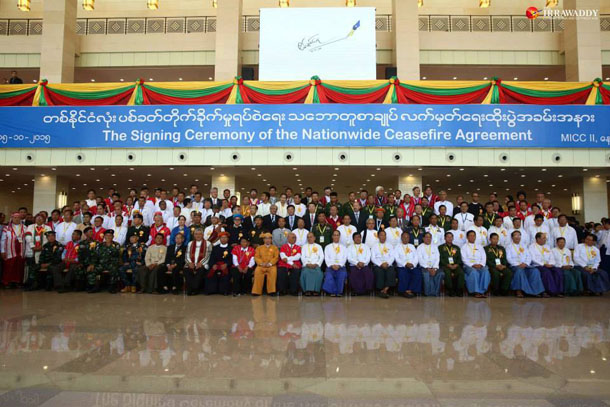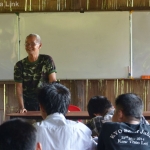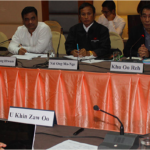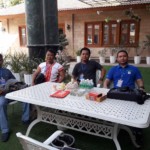Bertil Lintner / The Irrawaddy | January 10, 2016
Everything is looking good as the Burmese government and a number of ethnic armed groups prepare for a political dialog, which is soon to begin. On Oct. 15 last year, eight such groups signed a Nationwide Ceasefire Agreement with the government. Just as many groups did not sign, but the agreement nevertheless “silenced the guns in two thirds of the conflict areas. By strength of forces of the eight signatories, it’s like 80 per cent of the ethnic armed groups.”
That’s the situation in Burma’s conflict areas—if one is to believe what Tin Maung Thann, special adviser to the government-affiliated Myanmar Peace Center (MPC), said in an interview with Frontier Myanmar, a Rangoon-based magazine, which appeared on its website on December 24. Thant Myint-U, who has served as an adviser to President Thein Sein and the MPC, told Frontier on Jan. 7 that, “Thousands of hours of informal and formal talks have created an atmosphere of familiarity, if not trust, that did not exist before. We have an initial ceasefire agreement whose text has been almost universally agreed, with parliamentary ratification and international recognition.” Other peacemakers have said that the Oct. 15 agreement means that “the train has left the station, others can join later—or be left behind when the political dialog process begins.”
Reality on the ground, however, is entirely different. Almost the entire international and national media have swallowed the notion of “eight armed groups” having signed the agreement—but few have bothered to examine the list of those groups. The Karen National Union/Karen National Liberation Army (KNU/KNLA) is a genuine ethnic rebel group that has been fighting against the government since 1949, and it has an estimated 4,000 to 5,000 armed followers. But it remains bitterly divided over the agreement, which was signed by Gen. Mutu Say Poe, the KNU chairman. But shortly after the signing ceremony in Naypyidaw, two leading members of the KNU, vice president Zipporah Sein and veteran activist David Tharckarbaw, went to the Panghsang headquarters of the United Wa State Army (UWSA), Burma’s most powerful ethnic force which did not sign the agreement. Since the KNU was a signatory, they came as representatives of the Karen National Defense Organization, the movement’s village defense forces.
Two other Karen groups were among those that signed the October 15 agreement, one being the Democratic Karen Benevolent Army (DKBA) and the other the KNU-KNLA Peace Council. But the DKBA, which was originally known as the Democratic Karen Buddhist Army, has been, in effect, a government-allied militia since it broke away from the KNU/KNLA in late 1994. Since then, it has attacked and fought against the KNU/KNLA, not the government’s forces.
The DKBA may have 3,000 to 4,000 men in arms, and, thus, could be described as an armed ethnic group although it did not fight against the government. The “Peace Council” is another group that broke away from the KNU/KNLA, but, independent observers assert, it has no more than 50 men in arms. It entered into a bilateral ceasefire agreement with the government in 2007, and, according to By Force of Arms, a book written by researcher Paul Keenan, “was then able to sign a number of lucrative logging contracts with Thai companies.”
The Restoration Council of Shan State (RCSS), which was among the signatories of the Oct. 15 agreement, may have 6,000 to 7,000 soldiers. But they are based on the Thai border, where, according to a Bangkok-based, independent military analyst, “
The RCSS has an entirely different history. It grew out of the remnants of druglord Khun Sa’s Möng Tai Army (MTA). When he surrendered with most of his men to the Burmese government in January 1996, one of his commanders, Yawd Serk, refused to do so. He resurrected the Shan United Revolutionary Army (SURA), an older group which he and many other commanders had belonged to before it merged with Khun Sa’s forces in the mid-1980s and it all became the MTA. The “new SURA” later began to call itself “SSA”.
The real SSA, on the other hand, is about 2,000 to 3,000 strong, is active in central and northern Shan State—and did not sign the agreement. Its political wing is called the Shan State Progress Party (SSPP), which was set up in 1971, and is closely allied with the UWSA. The SSPP/SSA actually entered into a bilateral ceasefire agreement with the government back in September 1989, but in recent years—and months—it has come under heavy attacks by government forces.
The remaining four signatories of the Oct. 15 agreement—apart from the KNU/KNLA, the DKBA, the Peace Council and the RCSS—could not even be described as “armed ethnic groups.” The Pa-O National Liberation Organization is a one-man show led by a person who lives in Chiang Mai, Thailand. He was left behind when the main Pa-O outfit, the Pa-O National Organization/Army (PNA/PNO) entered into a ceasefire agreement with the government in March 1991.
The Arakan Liberation Party/Army (ALP/ALA) is a tiny group with a handful of followers who have never been active in Arakan State, also known as Rakhine. It was set up in 1972 in KNU-controlled areas on the Thai border where it maintained a small camp at the Karen base of Wangkha until it was overrun by government forces in the mid-1990s. Since then, it has been based in Mae Sot, Thailand.
The ALP/ALA should not be confused with the Arakan Army (AA), a much stronger rebel outfit that has been trained and equipped by the Kachin Independence Army (KIA) in the north. The AA has over the past year participated in battles in Kokang in northeastern Shan State and also launched a couple of surprise attacks in Arakan State.
The Chin National Front, which signed the agreement, is a badly factionalized group that has been active on and off in Chin State. But it has never had any armed force to be reckoned with, and Chin State is in any case the only ethnic state in Burma which has not had any widespread ethnic insurgency. This is usually attributed to the fact that the Chin speak more than 30 mutually unintelligible dialects and, therefore, lack the ethnic cohesion that is prevalent in other ethnic areas.
The last signatory is the All-Burma Students Democratic Front (ABSDF), which was set up at various places along Burma’s borders with its neighbors after the 1988 uprising. About a decade later, the main force gave up its armed struggle and began concentrating on information and propaganda. A remnant of the ABSDF fought on alongside the KIA in Kachin State, where it is still based. Its leaders were among the signatories in Naypyidaw in October. They have, however, vowed to fight if they are attacked, which may happen as the KIA did not sign the agreement.
Thus, it was as far from a genuine, nationwide ceasefire agreement—which it purported to be—as one could possibly get. Rather, the grand ceremony and the agreement that was signed in Naypyidaw on Oct. 15 should be seen as a face-saving gesture of the government-appointed MPC—and of the European Union, Norway and other donors, which have poured millions of Euros into the outfit, as well. After several years of talks, the MPC needed something to show international donors to justify what in reality amounts to a dismal failure to achieve peace across the country—and the international community was prepared to play along with the charade. Against this background, it is hardly surprising that the event was described by one observer of the political scene in Burma as reminiscent of Alice in Wonderland’s “Mad Hatters Tea Party.”
Among the groups that did not sign it are the country’s most powerful rebel armies, the 20,000-strong UWSA, its ally SSPP/SSA, the 5,000 to 6,000 strong and battle-hardened KIA with its political wing, the Kachin Independence Organization (KIO), and the Ta’ang National Liberation Army (TNLA), a Palaung group with at least 3,000 men in arms.
The Myanmar National Democratic Alliance Army (MNDAA) in Kokang, a district in northeastern Shan State inhabited by ethnic Chinese, also did not sign, nor did the National Democratic Alliance Army-Eastern Shan State (NDAA-ESS), which controls the Möng La region north of Kengtung. The MNDAA may have between 1,000 and 2,000 men in arms and the NDAA-ESS twice that number.
The UWSA, the MNDAA and the NDAA-ESS emerged from the collapse of the once powerful Communist Party Burma in 1989. Since then, especially the UWSA, has been able to procure from China modern weaponry, including surface-to-air missiles, mortars, artillery and even light tanks. The group may also have a limited number of transport helicopters, and it has been supplying not only the SSA but also the MNDAA and the TNLA with light weapons such as automatic and semi-automatic assault rifles.
As for the so-called “peace process,” Burma’s decades-long civil war has actually intensified since ex-general Thein Sein became the country’s president in March 2011 and, in November 2012, set up the MPC. The KIA, which had entered into a ceasefire agreement with the government in 1994, came under heavy attack in June 2011. The offensive against the KIA culminated in December 2012-January 2013, when the government’s army for the first time used Mi-35, Russian-supplied Hind helicopter gunships and Chinese-made Karakoram attack aircraft against the rebels.
In early 2015, fierce battles were fought between government forces and the MNDAA in Kokang—and this time the air strikes were much heavier and more intense than they were in Kachin State in 2012-2013. On May 20, 2015, military analysts at IHS/Jane’s said about the conflict in Kokang that the government’s army had launched “the largest war since Myanmar’s [Burma’s] independence.”
Overall, Burma has not seen such heavy battles in Shan and Kachin states since the 1980s. And before and after the Oct. 15 agreement was signed, heavy fighting raged around the SSPP/SSA headquarters at Wan Hai in central Shan State. That seems to have died down in recent months, but fighting has once again flared up in Palaung-inhabited areas in northern Shan State, where the TNLA has come under attack. RCSS troops have also attacked the TNLA, underscoring the fact that the Oct. 15 agreement caused not only splits within some of the signatories but also between groups that did and did not sign it.
On Jan. 7, more than 120 civil society organizations want the government to put on hold its “peace dialogue” until all the warring factions can be brought to the negotiating table. At the same time, the UWSA called the upcoming conference “meaningless” because it will exclude most important ethnic armed groups in the country.
Seen in a broader perspective, the entire “peace process” is flawed because the government wants to put the cart before the horse by insisting on an agreement—the one signed on Oct. 15—before any political issues have even been discussed. Details for how that ceasefire shall be implemented and monitored on the ground will also be discussed after they sign the agreement, not before.
In any normal peace process, a ceasefire can be announced at any time. Warring parties freeze their positions, and the ceasefire is then monitored on the ground. After that, talks are held about political issues, and, when a consensus has been reached, an agreement that will settle conflict and address the reasons for it can be signed. In short, it is a messy and upside-down process that can hardly lead to a lasting peace, nor solve the ethnic conflicts that caused the war to break out in the first place.
It is evident that the new government that takes over after Thein Sein’s would need to adopt an entirely different approach to the question of establishing peace in a country that had been torn apart by civil war for decades. As a first step to bring this tragedy to an end, the MPC should be dissolved, a new, more enlightened entity appointed—and international donors made to realize that they have to change their attitudes as well. So far, it has only been a total waste of money, and the Thein Sein government’s “peace process” has created more problems that it has solved.
This article originally appeared on The Irrawaddy on January 10, 2016.







